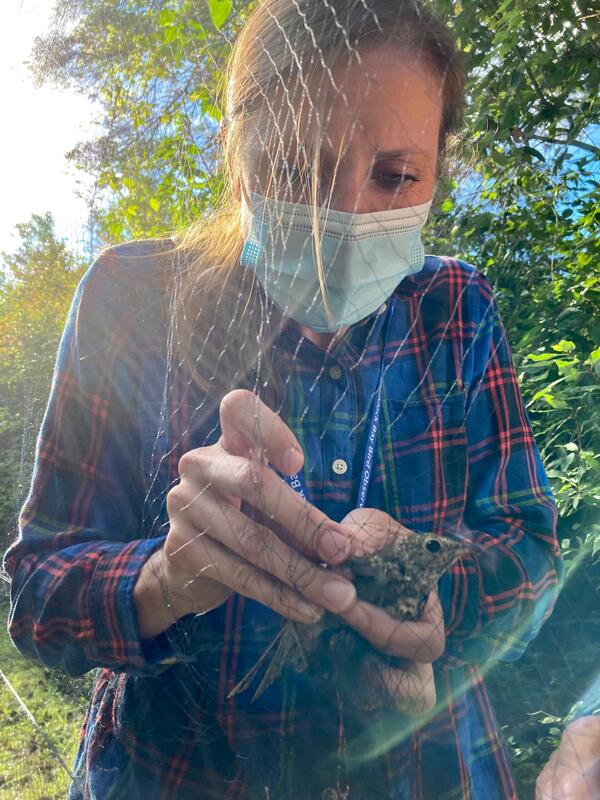An American Redstart wing being examined in the hand, the bright contrasting orange and black indicate this bird is an after hatch year male.
Images
An American Redstart wing being examined in the hand, the bright contrasting orange and black indicate this bird is an after hatch year male.
This is the first Prothonotary Warbler since 2007 at the BBL's Fall Migration Station.
This is the first Prothonotary Warbler since 2007 at the BBL's Fall Migration Station.
To age and sex Magnolia Warbler's in the hand, scientists look for clues in the tail. These large square white patches are an excellent indication that this bird is an after hatch year, male Magnolia Warbler.
To age and sex Magnolia Warbler's in the hand, scientists look for clues in the tail. These large square white patches are an excellent indication that this bird is an after hatch year, male Magnolia Warbler.
In the fall of 2022, the BBL's Fall Migration Station had a surprising number of early migrants pass through the station at the end of August, including an abundance of Blue-gray Gnatcatchers.
In the fall of 2022, the BBL's Fall Migration Station had a surprising number of early migrants pass through the station at the end of August, including an abundance of Blue-gray Gnatcatchers.

Elaine Nakash educates visitors and volunteers alike at the USGS Bird Banding Laboratory's display table, which was setup for the Latino Conservation Week event at the National Wildlife Visitor Center at Patuxent Research Refuge.
Elaine Nakash educates visitors and volunteers alike at the USGS Bird Banding Laboratory's display table, which was setup for the Latino Conservation Week event at the National Wildlife Visitor Center at Patuxent Research Refuge.

Bird Banding Laboratory Biologist, Stephanie Egger, extracts a thrush from a mist net.
Bird Banding Laboratory Biologist, Stephanie Egger, extracts a thrush from a mist net.

Stephanie Egger smiles for the camera with her Bird Safe Philly program supplies.
Stephanie Egger smiles for the camera with her Bird Safe Philly program supplies.
A Pacific Golden-Plover (Pluvialis fulva), like the one pictured, was originally banded with a USGS federal leg band in Alaska and then encountered in Japan several months later. Currently the BBL is working together with Japan's banding scheme to ensure bird movement data, like this, gets recorded from both schemes.
A Pacific Golden-Plover (Pluvialis fulva), like the one pictured, was originally banded with a USGS federal leg band in Alaska and then encountered in Japan several months later. Currently the BBL is working together with Japan's banding scheme to ensure bird movement data, like this, gets recorded from both schemes.
Black-and-white Warblers are one of the more common warbler species banded at the BBL's Fall Migration Banding Station.
Black-and-white Warblers are one of the more common warbler species banded at the BBL's Fall Migration Banding Station.

EESC Bird Banding Lab Team Photo Sep 15 2021_Tom O'Connell Credit. This photos show the team of banders at the bird banding station during fall migration at Patuxent Research Refuge
EESC Bird Banding Lab Team Photo Sep 15 2021_Tom O'Connell Credit. This photos show the team of banders at the bird banding station during fall migration at Patuxent Research Refuge
Melissa Roach, biologist with the Patuxent Bird Banding Lab, bands a pelican chick on Smith Island in the Chesapeake Bay.
Melissa Roach, biologist with the Patuxent Bird Banding Lab, bands a pelican chick on Smith Island in the Chesapeake Bay.
Three biologists with the USGS Bird Banding Lab at Patuxent Wildlife Research Center prepare to band pelican chicks on Smith Island in the Chesapeake Bay.
Three biologists with the USGS Bird Banding Lab at Patuxent Wildlife Research Center prepare to band pelican chicks on Smith Island in the Chesapeake Bay.
Two double-crested cormorant chicks in their nest on Smith Island in the Chesapeake Bay, Maryland.
Two double-crested cormorant chicks in their nest on Smith Island in the Chesapeake Bay, Maryland.
Think habitat: not grass. Powerlines that run through the Patuxent Wildlife Research Refuge, near Laurel, MD are managed as shrub habitat instead of mowed, which provides stopover habitat for migratory birds.
Think habitat: not grass. Powerlines that run through the Patuxent Wildlife Research Refuge, near Laurel, MD are managed as shrub habitat instead of mowed, which provides stopover habitat for migratory birds.












